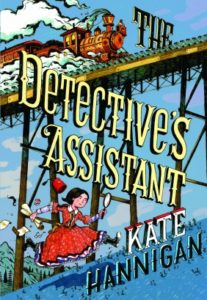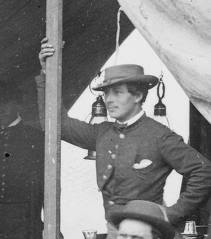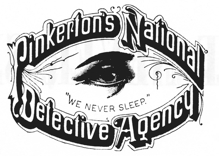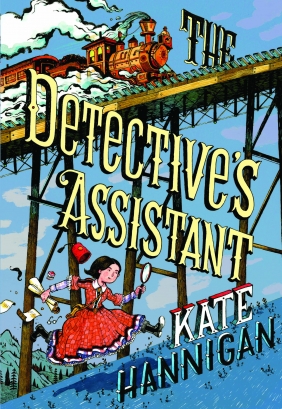craft review by Kristi Wright

The Detective’s Assistant by Kate Hannigan (Little, Brown, 2015)
Kate Hannigan’s historical novel, The Detective’s Assistant, is set right before Abe Lincoln is inaugurated as president. It intertwines the tale of a fictional orphaned eleven-year-old, Nell Warne, with the story of the real first female detective in America, Kate Warne, of Pinkerton’s National Detective Agency. Historical fiction always poses challenges in balancing historical accuracy with a fast-paced plot. When you add iconic characters like one of our most beloved presidents and a gaggle of famous Pinkertons, things become even more interesting.
Here are lessons I learned from Hannigan’s novel about incorporating historical elements and famous (and not-so-famous) real-life characters.
Hey, I Know Him!
Hannigan made conscious decisions about how she would portray both iconic characters, such as Lincoln, and less well-known characters, such as Kate Warne and Mr. Pinkerton.

Woman believed to be Kate Warne (cropped from a photo of Pinkerton and his associates)
With characters such as Kate Warne and, to a certain extent, Mr. Pinkerton, she allowed herself license to turn them into full-fledged characters in her novel. She grounded her characters in research and then extrapolated personalities and mannerisms that would work for her story while honoring their roles in history.
For example, since Mr. Pinkerton was an abolitionist in real life, Hannigan incorporates references to his secret life as an abolitionist into the story.
With Kate, Hannigan even gives a nod to the fact that people couldn’t wrap their heads around the idea of her being a detective. Nell cannot guess what Kate does for Mr. Pinkerton:
“‘Are you a secretary for that Pinkerton? Or a bookkeeper?’
“‘No Nell,’ she said, her voice tight. ‘I do not file his papers or keep his books. Nor do I take down Mr. Pinkerton’s dictations’” (pg 49).
Nell continues to guess. She even imagines that Kate is Mr. Pinkerton’s washerwoman.
This fictional interchange pays homage to the confusion that people had about Kate and her working relationship to Mr. Pinkerton. It also grounds us in a world where women aren’t expected to do certain types of jobs.
Hannigan keeps her imagination on a much firmer leash with Lincoln. She introduces us to him via a newspaper article (pg. 47), where she describes him as “. . . six feet high, crooked-legged, stoop shouldered, spare built, and anything but handsome in the face.” Whether this is a fictional article or one taken from historic archives, Hannigan uses a newspaper publication that existed in the 1860s, and her description is in keeping with those expressed in Lincoln’s lifetime.
Later when Nell and the Pinkertons are embroiled in a dangerous plot that has Lincoln at the center, mostly, Hannigan keeps Lincoln as a shadowy presence.
We hear about him through whispered dialogue:
“He is so tall, he cannot even lie straight in his berth” (pg 313).
There is only one moment in the entire story when the main characters actually meet Lincoln. Otherwise, he remains off-stage, though a powerful presence.
Action: If your historical figure is famous then you should stick to historical accuracy as much as possible. The less famous your historical figure, the more liberties you may choose to take!
Specific Words, Specific Details
Hannigan makes a number of specific choices with the language she uses in the story. She doesn’t use dialect (a conscious choice), but she does choose language that telegraphs her historic setting.
First, she uses an old-fashioned structure for her chapter titles. For example: In Which Aunt Kitty Transforms into a Southern Belle, and I Get a Bit Choked Up (pg 180).
 Second, she uses a more formal language with fewer contractions than is common now.
Second, she uses a more formal language with fewer contractions than is common now.
Third, she threads in words that scream historic setting. Often she uses them in dialogue and thoughts to incorporate them organically. For example:
“‘Take in this gangly urchin you claim is one of my kin? One look tells me the child hasn’t made the acquaintance of a bar of lye in a good many years, not to mention being in the same two-mile vicinity of a comb’” (pg 1).
Note “gangly urchin”, “kin”, “bar of lye”, and “comb”.
On the second page, the “Right Reverend” says, “You are the waif’s last relation in the world. Without you, the child is destined to a most piteous life in the orphan asylum” (pg 2).
Again, note words like “waif”, “piteous”, and “orphan asylum”.
Throughout the novel, Hannigan is careful to pick the words that will most bring her readers into this pre-Civil War world she has built.
Finally, Hannigan uses metaphors and similes that feel accurate to the time period.
“She folded her hands neatly in her lap as if she were Queen Victoria herself on the throne” (pg 11).
“I’ll stick with her like a tick on a fat dog” (pg 15).
“…arguing with her would be as useful as squabbling with the striped wallpaper” (pg 35.)
“Puffed up proud like a rooster…” (pg 38).
“An uneducated girl is worse than a lame horse” (pg 87).
Action: Have fun with word choice in building your world. Whenever possible, pepper words that evoke a historic sensibility into dialogue to keep an action-packed pace.
What are your favorite tricks for historical worldbuilding?
Kristi Wright (co-editor) writes picture books and middle grade novels. Her goal as a writer is to give children a sense of wonder, a hopefulness about humanity, and a belief in their future. She is represented by Kurestin Armada at Root Literary. She is an active volunteer for SCBWI and a 12 X 12 member. Find her at www.kristiwrightauthor.com and on Twitter @KristiWrite.


COMMENTs:
0